"The common cuckoo is very much oiseau du jour at the moment, with satellite-tracked individuals providing a unique glimpse into their migratory world. But it's not just this latest study that has brought the species close to the nation's heart; its distinctive song – the herald of spring and the essential backing track to a warm summer's evening – and its famed egg-laying habits have given the species a special place in tradition, folklore and clocks. What of the globe's other 143 species, though? Members of the Cuculidae family occur on all of the world's vegetated continents. Some, like the roadrunners of Central America, are as well known as Europe's common cuckoo; others, like the Moluccan drongo-cuckoo of Wallacea and the couas of Madagascar, less so. Cuckoos of the World, the latest in the Helm Identification Guides series, covers them all.
The introductory section gives a fascinating overview of this varied family, from systematics to conservation. The colour plates are magnificent, painted by four different artists but sitting side by side without any clash in styles. A single plate includes multiple illustrations for up to six species but it's largely clear which illustrations belong to which species, and the space is generally well used without feeling cluttered. The maps are clear and easy to understand, so long as you know which part of the world you're looking at – a map containing just an island group can be hard to put into context until you've read the text. Dotted lines denote subspecies limits, an extremely useful addition missing from a surprising number of other publications. The photography is stunning and it's an impressive statistic that close to 140 of the species featured in the book have at least one in-the-field photograph associated with the them; my personal favourites are the dazzling African emerald cuckoo featured in the introduction and the pastel-shaded grey-capped cuckoo on page 307.
The text is split into different sections: Alternative names; Taxonomy; Field Identification; Voice; Description; Biometrics; Moult; Geographic Variation; Distribution; Habitat; Behaviour; Breeding; Food; and Status and Conservation. I found the Behaviour and Breeding sections the most enlightening, perhaps not surprising given the fascination in cuckoos' nesting habits. The family as a whole employs a wide range of nesting techniques, from obligate brood parasites of other species to monogamous pairs who raise their own young in their own nest. Even within a species, a range of nesting practices are displayed. For example, I learnt that some pairs of yellow-billed cuckoo raise their own young, occasionally with the added assistance of a 'helper male'; some females may lay their eggs in the nest of an unrelated pair of yellow-billed cuckoos; and some females may lay their eggs in the nest of an unrelated species such as black-billed cuckoo, American robin or even mourning dove. If that list seems varied, the list of species parasitized by common cuckoos is quite mind-blowing: black-eared wheatear, Moussier's redstart, Tristram's warbler, Isabelline shrike, black-headed bunting, scrub warbler, to name a few of the more unusual. The species text accounts really are a fascinating read.
However, as interesting as these accounts are, the reading can sometimes be hard going. The writing occasionally contradicts itself, while sentences lack flow and occasionally give the impression that Yoda might have had an input into their syntax. Confusing sometimes this can get. Illustrating the point nicely, from the long-tailed koel distribution section: "Makes non-stop flights of up to 3,000km (Robertson 1985) but vagrants to Palau I. cover nearly 6,000km over open sea (Dorst 1962). Once Queensland (Barrett et al. 2003), an earlier record, and two NT, Australia, considered unconfirmed (Higgins 1999)."
I have further reservations with this book, though perhaps less critical to the average user. "Great," I thought when the publication first arrived on my desk, "I'll be able to look up the latest moult information and ageing criteria for Common Cuckoo" – such are the priorities in my life. I was disappointed to find that the moult section for the species consisted of one sentence about timing of body moult. And, since the most widespread method for ageing common cuckoos relies on the assessment of retained secondaries (not mentioned under 'Moult'), it's perhaps not surprising that the only age classes covered under 'Description' are juvenile and 'adult'. Perhaps I'm being pedantic. After all, ageing common cuckoos is subtle at best; so how about a more obvious species, the great spotted cuckoo? The species often shows a distinctive first-summer plumage – so much so that it's even illustrated in some general-purpose field guides. Sadly in cuckoos there is not even so much as a hint that there might be a recognisable plumage between juvenile and 'full adult'.
Ultimately, this book does shine brightly in many areas. If you can overlook the absence of some of the more technical aspects of morphology – and the slightly hefty price tag – then the artwork, the photographs, the illuminating text on behaviour and nesting, and the overview of identification of all the world's cuckoos are likely to make this book an attractive addition to the Helm Identification Guides family."
- Stephen Menzie, www.birdguides.com, Wednesday 22nd August 2012
"Since this is the third major review of the Cuculidae in the last 15 years, following Bob Payne’s work for HBW (1997, which recognised 136 species) and his standalone monograph, The Cuckoos, in the OUP Bird Families of the World series (Payne 2005, 141 species), purchasers might justifiably expect something special here. Certainly an experienced team of authors was assembled, but do they deliver?
Although most cuckoos have been well covered in field guides, the plates here, by four artists, are very good (and vastly superior to those in Payne 2005). New World species suffer from being reproduced fractionally too small, while the Malagasy couas are scattered over four plates, one well separated from the others (with two species’ plate legends reversed), and two South American Coccyzus are ‘shunted’ onto a plate of malkohas, ‘orphaned’ from their congenerics. There is also an admirable selection of photographs (some of them stunning) adorning the species accounts, providing another plus over the Payne monograph (while species coverage exceeds that in HBW, gaps remain) .
The 144 species accounts comprise sections on Taxonomy, Field Identification, Voice, Description, Biometrics, Moult, Distribution, Habitat, Behaviour, Breeding, Food, and Status and Conservation. Some are broken into clear subsections, enabling easy access to desired information, where available. Most accounts span 2–5 pages, including photographs and maps. Texts are telegraphic, an often necessary device in field guides, but a more discursive style would be my preference in works of this nature. Some of the abbreviations (explained on p. 26) seem pointless: PNG (Papua New Guinea) is doubtless self-explanatory, but NG (New Guinea) and IC (Ivory Coast), to name two, will be less obvious, and scarcely necessary as space-saving devices. Although the book is well referenced, with a very extensive bibliography, some very lengthy sections close with an extensive list of relevant citations, making at least some facts difficult to research. The text evidently has been prepared over a long period and certain sections would have benefited from more rigorous editing to ensure their fluidity, and to remove inconsistencies and contradictions.
Undoubtedly a huge amount of work has gone into this book, but the personal touch is often missing, with large quantities of data (including virtually all of the biometrics) lifted wholesale from Payne (2005). Although there is little point in reinventing the wheel, extensive, specimen-based research will often yield useful insights. These authors appear to have relied heavily on personal visits to very few different institutions and, although they assembled a huge body of specimen data to create detailed range maps (available at www.fullerlab.org/cuckoos) on which the book’s versions are based, reliance on online or other databases is not ideal. Subspecific taxonomy appears heavily based on the literature, although some references (e.g. for white-browed coucal Centropus superciliosus) have been missed, with little evidence of novel research. Many of the voice sections would have benefited from use of internet forums such as the well-established xeno-canto database. Indeed, online resources, which have the potential to add a whole new dimension to the workload for authors, are rarely cited, as is correspondence with other researchers, despite many fellow ornithologists being thanked on pp. 9–10.
True errors appear rare, but ‘slips’ are not difficult to locate. A revision of the type locality of the nominate taxon of rufous-vented ground cuckoo Neomorphus geoffroyi (Raposo et al. 2009; Zootaxa 2176: 65–68), which has obviously important implications for nomenclature, was missed. In a plea for reassessment of a Finnish record of Jacobin cuckoo Clamator jacobinus, Lees & Mahood (Dutch Birding 33: 325–328) mention several published instances of vagrancy, e.g. in Iran, as well as increasing records in Thailand, which escaped Erritzøe et al. It is stated that there is just one confirmed Brazilian record of mangrove cuckoo Coccyzus minor, but two are mentioned, and additional photographs from other localities are available on www.wikiaves.com.br. A detailed discussion of parasitic behaviour by common cuckoos Cuculus canorus includes a lengthy list of hosts broken down by region but omits at least one species, rufous-tailed scrub robin Cercotrichas galactotes, known in Turkey (Kirwan et al. 2008). A symbol employed on some maps goes unexplained on pp. 22–23, although its meaning is reasonably apparent.
To answer the question I posed in the first paragraph, anyone whose avian interests extend well beyond the Western Palearctic, and who lacks Payne’s monograph (which contains substantially more detailed introductory sections), should certainly consider the present work, especially if they do not own HBW. But, for those who do, I suspect that the decision concerning this attractive book might rest on the depth of their pockets."
- Guy Kirwan, www.britishbirds.co.uk, 30-10-2012





















































